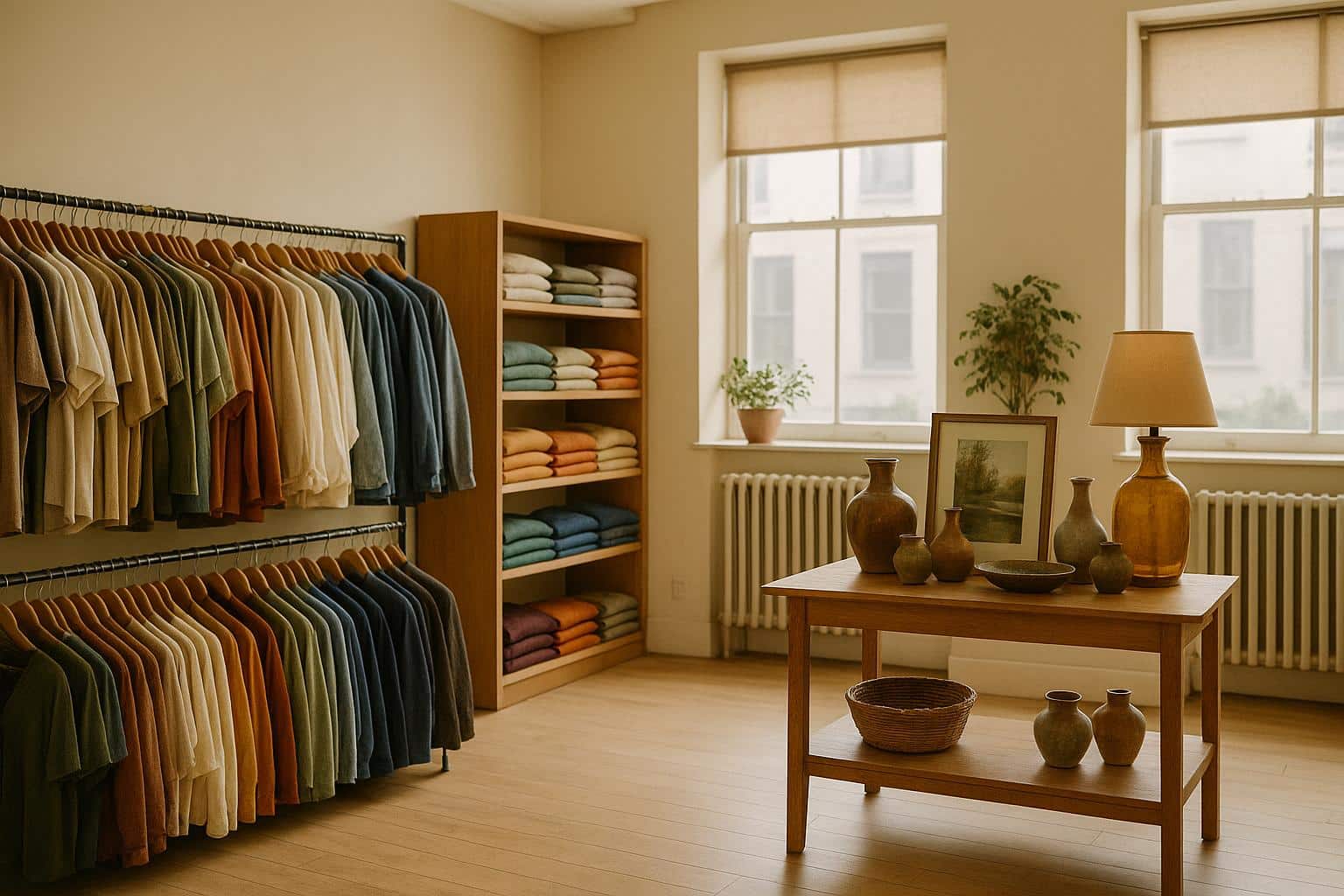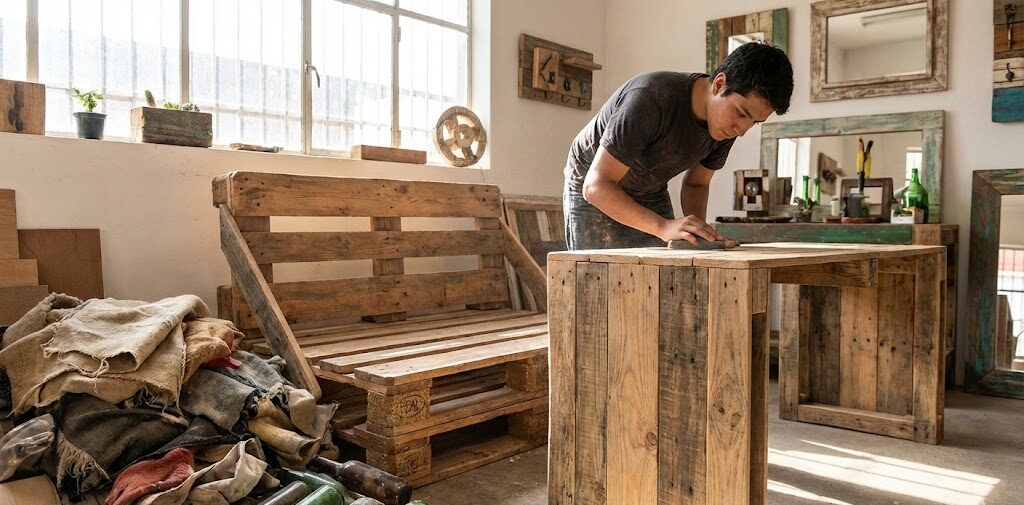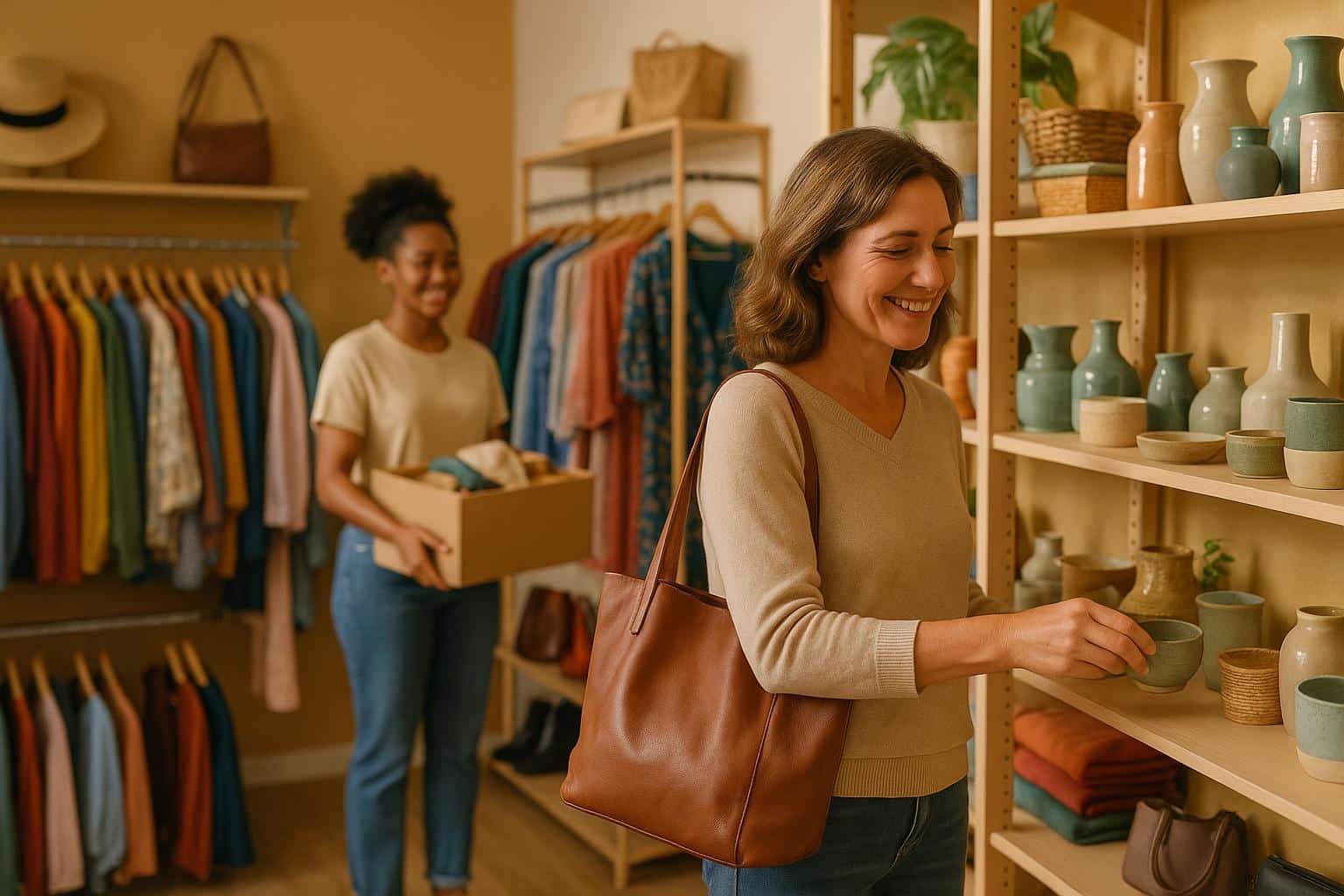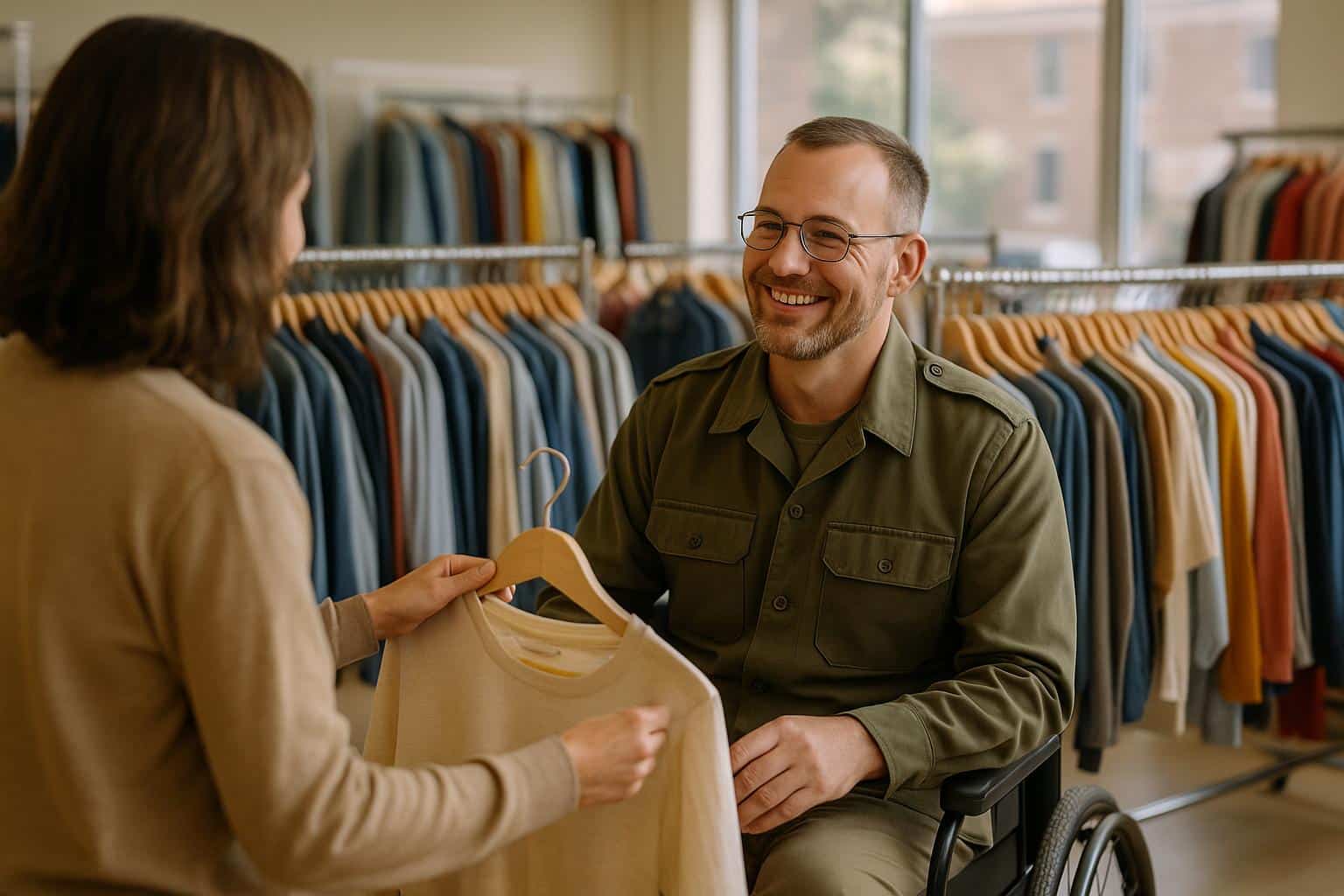
Creating an effective thrift store layout can transform the shopping experience, making it easier for customers to browse, find items, and spend more time in your store. A well-organized space encourages purchases, reduces frustration, and keeps shoppers coming back. Here’s a quick summary of the key layout strategies:
- Eye-Catching Window Displays: Showcase your best items and update displays every 4–6 weeks to draw in foot traffic.
- Welcoming Entrance: Keep the entry area open, clean, and well-lit to set the right tone.
- Angled Aisles: Use diagonal aisles to improve flow and product visibility.
- Strategic Checkout Placement: Position counters near the front left to guide customers past more items and reduce theft risks.
- Seasonal Displays: Highlight timely items in high-traffic areas to drive interest and sales.
- Movable Fixtures: Use rolling racks and adjustable shelving to easily rearrange for changing inventory.
- Guided Pathways: Create clear pathways, like racetrack layouts, to encourage exploration and minimize congestion.
These tips not only improve customer satisfaction but also boost sales and help thrift stores better serve their communities.
1. Create Eye-Catching Window Displays
Your store’s windows are more than just glass – they’re your first chance to grab attention and invite people in. In fact, window displays can influence up to 24% of purchase decisions, making them a crucial part of your marketing strategy.
Show off your best finds to spark interest. Experts recommend showcasing only your top-tier items in the windows and near the entrance. Think of it as a sneak peek into the treasures inside – whether it’s a vintage leather jacket, a designer handbag, or a one-of-a-kind home décor piece, your display should make people curious enough to step inside.
Seasonal themes are a reliable way to draw in foot traffic. During the summer, you could highlight camping gear or beach accessories. When back-to-school season rolls around, put student items and trendy outfits front and center. Did you know that 79% of shoppers enjoy holiday-themed displays, and 43% are more likely to visit stores with festive windows? Incorporating these elements with eye-catching designs can make a big difference.
Don’t underestimate the power of color. Bright, bold hues naturally draw the eye and make your display feel welcoming. Use vibrant color combinations to ensure your windows stand out.
The key is to keep things fresh. Displays that stay the same for too long tend to fade into the background for regular passersby. Aim to update your windows every 4–6 weeks to maintain interest and encourage discovery.
Take a page from Red Racks Thrift Stores. They rotate their window displays regularly to not only attract new customers but also remind loyal shoppers that fresh inventory is always coming in. This approach has been shown to increase foot traffic by up to 50%. Plus, it reinforces their mission of offering affordable goods to the community. Regular updates keep the excitement alive and bring people back for more.
2. Design a Clear and Welcoming Entrance
The entrance to your store is where first impressions are made, and it sets the tone for the entire shopping experience. This space should feel open, clean, and inviting, offering a glimpse of what customers can expect inside. Avoid overcrowding the area – let it breathe and reflect your store’s atmosphere.
Clarity is key. Keep sightlines clear so visitors can easily see displays along the perimeter. Avoid large fixtures or excessive signage that might obstruct these views, as they can make the space feel cramped or confusing.
Lighting plays a big role in creating an inviting and safe environment. Bright, evenly distributed lighting not only enhances the appeal but also subtly influences how customers perceive your store. Good lighting can act as a silent salesperson, making the entrance feel warm and approachable.
Take advantage of natural movement patterns to guide customer flow. Since most shoppers instinctively turn right upon entering, consider placing new arrivals or sale items in that direction to encourage exploration. A standout focal point – like a striking display of your best seasonal or unique items – can also grab attention and invite customers to linger. This thoughtful layout naturally leads into an engaging store experience.
For example, Red Racks Thrift Stores make great use of clean, well-lit entryways and clear pathways to create a welcoming environment that showcases their diverse selection of donated treasures.
Finally, use signage wisely. Keep entrance signs bold and simple to grab attention without adding clutter. A clean, engaging design can reflect your store’s energy and enthusiasm while making a strong first impression.
3. Use Angled or Diagonal Aisles for Better Flow
The way you arrange your aisles can significantly influence how customers navigate your store. Angled or diagonal aisles, compared to the traditional straight-line setup, create a more engaging shopping experience. They encourage customers to explore a wider range of merchandise, often leading to more time spent browsing and, potentially, more purchases. This layout not only enhances product visibility but also improves the overall flow of foot traffic.
One of the standout benefits of diagonal aisles is how they improve product visibility. By angling aisles – typically at 45° relative to the main walkway – customers naturally see more items as they move through the store. This increased visibility can lead to more impulse buys and help shoppers discover products they might otherwise overlook in a standard grid layout.
Diagonal layouts also promote smoother traffic flow. Instead of moving in rigid, straight paths, shoppers are guided in a more natural, weaving pattern. This design encourages them to explore different sections of the store, increasing the chances they’ll encounter a variety of product categories. With strategic planning, diagonal aisles can even guide customers toward specific areas, such as the checkout counter, by subtly directing foot traffic in that direction.
If you’re considering diagonal aisles, start by carefully measuring your space and drafting a layout that balances traffic flow with product placement. Use the angled sections as focal points for key items or promotional displays. And don’t forget to ensure the aisles are wide enough for customers to move comfortably – overcrowded spaces can diminish the inviting atmosphere that diagonal layouts are meant to create.
For thrift stores like Red Racks Thrift Stores, diagonal aisles are especially effective. They allow for better exposure to the variety of donated items and keep the shopping experience fresh. Experimenting with angles beyond the typical 45° can also be a great way to highlight seasonal items or special donations.
4. Position the Checkout Counter Strategically
The placement of your checkout counter plays a key role in shaping the shopping experience, ensuring security, and encouraging impulse purchases. A well-thought-out location can reduce wait times, minimize abandoned purchases, and create opportunities for last-minute sales.
Optimal Placement for Maximum Impact
In the United States, placing the checkout counter on the left side of the store, near the front, is a smart move. This layout aligns with natural shopping behaviors, guiding customers past a variety of products before they reach the counter. Positioning it near the entrance or in a central spot also acts as a natural checkpoint, improving visibility and reducing the risk of theft.
Space Requirements and Accessibility
To comply with the ADA Standard for Accessible Design, leave 30–40 inches of space in front of the counter to accommodate wheelchair users. Additionally, ensure there’s sufficient room behind the counter so your staff can work comfortably without feeling crowded.
Security Benefits Through Strategic Positioning
Placing cash registers close to the entrance not only adds convenience but also enhances security. This setup creates a natural surveillance point, allowing staff to monitor the store more effectively. Many large retailers use this strategy to maintain a secure shopping environment.
Choosing the Right Counter Configuration
The layout and size of your store should dictate your checkout counter design. For smaller stores, a single countertop checkout counter is a space-efficient choice. Medium-sized stores may benefit from dual cash wrap units, offering more surface area for transactions. Larger, high-traffic stores might require a three-part cash wrap, which accommodates multiple cashiers and additional customer service needs. These configurations also provide excellent opportunities to showcase impulse-buy items.
Maximizing Impulse Purchase Opportunities
The checkout zone is prime real estate for impulse buys. In 2020, monthly spending on impulse purchases rose by 18%, reaching an average of $182.98. Use this space to create a mini “shopping alley” by displaying small, enticing items that require little explanation. Business consultant Lynn Switanowski explains:
“Such products don’t need a lot of explaining. It sells itself (because) you understand what it does.”
Encourage suggestive selling at checkout to nudge customers toward additional purchases.
At Red Racks Thrift Stores, the checkout counter serves as the final interaction point, tying together the entire shopping journey. By positioning it thoughtfully, you can ensure a secure, efficient, and profitable end to every customer visit.
5. Highlight Seasonal and Featured Displays
Seasonal displays have a way of captivating customers while creating a sense of connection. By tapping into the natural rhythm of the year, these displays remind shoppers of upcoming events and spark interest in relevant items.
Strategic Timing for Maximum Impact
Timing is everything when it comes to seasonal displays. Planning ensures your store is ready for key transitions. For instance, showcase winter gear during October and November, and highlight summer essentials in April and May to align with peak demand. A well-thought-out calendar helps you stay on track and ensures your displays are always timely and relevant.
Creating Urgency Through Visual Appeal
Eye-catching displays encourage quick decisions and spur impulse buys. As Kyle Payton, a retail expert, puts it:
“Tasteful seasonal decor makes your thrift store feel more organized and welcoming, which increases customer engagement.”
This combination of style and strategy can make your store feel inviting and encourage shoppers to linger.
Prime Placement Strategies
Where you position your displays matters just as much as how they look. Set up seasonal displays in high-traffic areas like the front window, entrance, or main walkways to grab attention. Using mannequins or working with an interior decorator can elevate the presentation, making your thrift items feel more curated and valuable.
Keeping Displays Fresh and Relevant
An outdated display can quickly lose its charm. Regular updates – whether monthly or quarterly – help keep things fresh and aligned with seasonal changes, holidays, or special promotions. Pay attention to customer reactions and sales data to fine-tune your setups. Staying in sync with trends and shopper preferences ensures your displays stay engaging and effective.
Boosting Sales with Strategic Promotions
Pairing your displays with smart promotions can amplify their impact. Adjust prices strategically to align with peak holiday traffic, creating a sense of value while also moving inventory. This approach combines visual appeal with attractive pricing, offering customers a compelling reason to shop and boosting your bottom line.
At Red Racks Thrift Stores, seasonal displays do more than showcase merchandise – they tell stories. These displays connect donated treasures with customers’ needs, whether for an upcoming celebration or everyday essentials. By focusing on what matters most to their audience, Red Racks transforms routine shopping trips into memorable experiences, all while reinforcing their commitment to community access.
6. Incorporate Flexible and Movable Fixtures
Thrift stores face the unique challenge of constantly changing inventory – one week it’s winter coats, the next it’s children’s toys. To keep up, they need fixtures that can adapt on the fly. That’s where flexible and movable setups come into play.
Rolling Racks and Adjustable Shelving: A Winning Combo
Rolling garment racks (around $118.40) are a game-changer. These mobile racks make it easy to rearrange store layouts to handle large donations or to highlight specific merchandise categories. With just a quick push, staff can create more space where it’s needed most.
Adjustable shelving systems are another smart solution. Unlike fixed shelving, these can be tailored to fit different item sizes and types. What’s more, movable shelving can free up to 50% of floor space by eliminating static aisles and replacing them with flexible, movable ones. For thrift stores where every square foot counts, this efficiency is invaluable.
Modular Displays That Evolve With You
Gridwall gondolas and pipeline collections bring versatility to the table. A Gridwall Gondola with 5′ Grid costs between $181.50 and $206.80, while Pipeline Adjustable Double Bar Ballet Racks start at $399.00. These systems can be customized with hangrails, baskets, and other accessories, making them ideal for ever-changing inventory needs.
Amanda Costello, a Visual Merchandising Leader, highlights the benefits of modular systems:
“Using modular and flexible retail displays offers several benefits that I find invaluable. First, they allow me to quickly adapt to changing trends and customer preferences without a complete overhaul…Secondly, they enable efficient use of space…Lastly, modular systems reduce costs in the long run.”
This adaptability isn’t just theoretical – it’s backed by real-world results.
Real-World Success with Flexible Fixtures
Flexible fixtures don’t just make life easier for store staff – they can also boost sales. Take the flagship Manhattan store of Goodwill Industries of Greater New York and Northern New Jersey. In Q3 2024, they revamped their layout with Gridwall Gondola displays and Rolling Garment Z Racks under the leadership of Store Operations Manager John Smith. The result? A 15% sales increase within three months, thanks to better product visibility and smoother customer flow. They also cut the time spent rearranging displays by 20%, freeing up staff for other tasks.
Smart Choices for Maximizing Space
Heavy-duty double bar clothing racks with V-braces ($150.80) combine stability with mobility, making them perfect for handling heavier loads while still being easy to reposition. For added storage, wire top baskets ($98.95) can be attached to these racks, creating vertical storage without taking up extra floor space.
Spacesaver’s Flexible Shelving caster bases are another standout option. With a maximum load capacity of 1,620 lbs. per 72″ base, these durable yet mobile units can handle the demands of a busy thrift store.
Keeping Shopping Experiences Fresh
Flexible fixtures don’t just improve store operations – they also keep customers engaged. Studies show that fresh layouts and dynamic arrangements can boost sales by 80%–478%. When shoppers encounter new displays, they’re more likely to explore the store and discover hidden gems.
At Red Racks Thrift Stores in Missouri, flexible fixtures play a key role in creating a curated shopping experience. By adapting quickly to community donations, they ensure that customers always find a well-organized selection of clothing, unique treasures, and more – all while supporting veterans and the local community.
7. Guide Customers with a Thoughtful Pathway Layout
How customers move through your thrift store plays a huge role in their overall experience. A smartly designed pathway layout doesn’t just prevent overcrowding – it also encourages shoppers to explore every nook and cranny of your store.
The Racetrack Layout: A Natural Flow
One layout that works wonders is the racetrack design. This loop-style layout guides customers effortlessly around the entire store. It eliminates dead ends, ensures steady foot traffic in all areas, and, with its open pathways, reduces congestion.
Placing Products with Purpose
Don’t make the mistake of putting your best items right by the entrance. Instead, spread your top sellers throughout the store to encourage shoppers to browse every section. Another smart move? Place high-demand products on the right side of the store. Why? Many people instinctively turn right when shopping.
These strategies not only improve flow but also enhance the shopping experience.
Creating Stops That Catch Attention
Strategically placed displays can slow down shoppers just enough to draw their attention to key products. Think endcaps, mid-aisle setups, or seasonal displays. Nordstrom, for example, uses varied layouts to create natural pauses, effectively directing customer focus to specific items.
Boosting Impulse Buys and Keeping It Fresh
Endcaps and mid-aisle displays are also great for driving impulse purchases. Plus, they help keep the store layout dynamic, offering customers a reason to return and discover something new.
Take a page from Red Racks Thrift Stores, whose thoughtful pathway design ensures smooth navigation through diverse sections like clothing and unique treasures. Their layout not only creates an enjoyable shopping journey but also supports their mission of serving veterans and the Missouri community. By blending engaging pathways with other layout strategies, they’ve created an inviting space that encourages shoppers to explore and discover.
Layout Style Comparison
Selecting the best layout for your thrift store hinges on factors like available space, the variety of merchandise, and how customers move through your store. Each layout style has its own strengths and weaknesses, and understanding these can help you make better design decisions.
The grid layout is a go-to choice for stores with a wide range of inventory. Its structured design maximizes display space and feels familiar to shoppers. However, it might overwhelm customers in smaller spaces and doesn’t lend itself to an immersive browsing experience.
For stores with limited space, the free-flow layout offers a more relaxed and open shopping environment. This style works particularly well for boutique thrift stores with carefully curated items. On the downside, it provides less display space and can confuse shoppers who prefer a clear, organized path.
The herringbone layout shines in long, narrow spaces where maximizing product display is key. While it’s highly efficient for tight spaces, the arrangement can feel cramped, potentially discouraging shoppers from lingering.
If your priority is ensuring customers see every section, the loop (or racetrack) layout might be the answer. This layout directs shoppers along a set path, offering full product exposure. However, it limits their ability to browse freely, which may detract from the shopping experience.
Here’s a quick overview of the different layout styles:
| Layout Style | Best For | Key Advantages | Main Drawbacks |
|---|---|---|---|
| Grid | Large stores with varied inventory | Maximizes display space; familiar to shoppers | Overwhelming in small spaces; less engaging |
| Free-Flow | Small, curated thrift boutiques | Encourages relaxed browsing; open feel | Limited display space; less structured |
| Herringbone | Long, narrow spaces with many items | Makes the most of minimal space | Can feel cramped; reduced visibility |
| Loop/Racetrack | Stores focused on full product exposure | Predictable path; ensures all sections are seen | Limits browsing freedom |
| Diagonal | Compact stores | Enhances customer flow | Prevents shortcuts to specific areas |
Many successful thrift stores combine elements from different layouts to create a more dynamic shopping experience. For example, a store might use a grid layout for general merchandise while incorporating free-flow or diagonal designs in specific sections to encourage exploration.
Conclusion
An effective thrift store layout does more than organize merchandise – it creates a space that invites discovery and strengthens ties to the community. By adopting thoughtful layout strategies, you can enhance the shopping experience while amplifying your store’s impact.
Consider this: 70% of secondhand shoppers prefer in-store shopping for apparel over online options. That makes your physical store the central stage for engaging customers. Add to this the fact that in 2023, nearly half of U.S. consumers’ clothing budgets were spent on secondhand items, and it’s clear that a well-designed store layout represents a major opportunity for thrift shops to connect with their audience and further their mission.
Take Red Racks Thrift Stores as an example. With 12 locations across Missouri supporting Disabled American Veterans, their success hinges on creating spaces where customers can easily navigate, find what they need, and uncover hidden gems. When the shopping experience is seamless and enjoyable, customers are more likely to return – and to support the cause behind the store. A strong layout doesn’t just boost sales; it also strengthens the connection between your mission and your community.
Key elements like strategic checkout placement, clearly defined aisles, and eye-catching seasonal displays can significantly increase the value of every donated item. This translates into more funds for community programs, extended use of donated goods, and a stronger overall impact.
Your store layout isn’t static – it should grow and adapt alongside your inventory and customer needs. Regular updates to displays, lighting, and traffic flow ensure that your store remains both functional and inviting. Done right, your layout becomes a tool for turning casual visitors into loyal supporters, reinforcing your role as a trusted retail space and a cornerstone of community support.
FAQs
How often should I refresh my thrift store’s window displays to keep customers interested?
To keep your thrift store’s window displays interesting and appealing, try updating them every 2 to 3 weeks. Regular changes keep customers curious and give them a reason to stop by more often, eager to see what’s new.
Focus on showcasing seasonal themes, standout items, or current promotions to make your displays pop and stay relevant.
Why should thrift stores consider using diagonal aisles instead of straight-line aisles in their layout?
Diagonal aisles can change the way customers experience a thrift store by making the space feel more open and welcoming. Unlike straight aisles, diagonal layouts naturally lead shoppers through the store, encouraging them to wander and discover items they might have otherwise missed.
Another major perk is better product visibility. Diagonal aisles allow customers to see a wider range of merchandise as they move through the store. This layout helps draw attention to key sections and subtly guides shoppers toward important areas like featured displays or the checkout. By creating a more engaging and fluid shopping experience, this design can leave customers happier and even contribute to higher sales.
How can I use seasonal displays to attract more customers and boost sales in my thrift store?
Seasonal displays are a smart way to catch shoppers’ eyes and boost sales in your thrift store. By featuring items that tie into current holidays, seasons, or popular trends, you can create a shopping vibe that’s both inviting and timely. Regularly refreshing your window and in-store displays to reflect the season keeps things exciting. Position seasonal items in high-traffic areas, like near the entrance or at the front of the store, so they immediately grab attention.
Seasonal themes do more than just spruce up your store – they create a sense of urgency. Customers are more likely to buy when they feel they might miss out once the season ends. If the weather cooperates, outdoor displays can also be a great way to draw in passersby and increase foot traffic. These straightforward strategies can make your store more dynamic and help drive sales during key times of the year.





